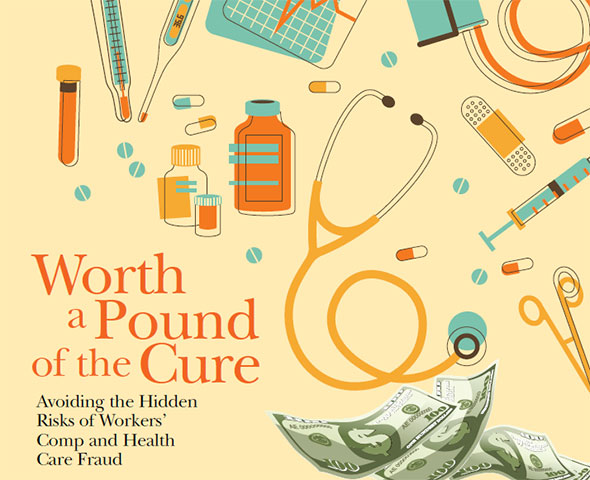
Avoiding the Hidden Risks of Workers’ Comp and Health Care Fraud
By many estimates, health care fraud costs U.S. taxpayers approximately $200 billion a year—about 5 to 10 percent of the nation’s health care expenditures. Annually, that amounts to hundreds of dollars per person worth of health care coverage, which is a cost that often comes in the form of increased premiums.
However, according to Paul Baker of Marietta-based Sterling Risk Advisors, outright cases of fraud only constitute part of the problem. “While fraud is present and is an issue in the system, strict fraud probably only accounts for about 10 percent of the total claims expense,” explains Baker. “This is significant, but not to the same extent that exaggeration of injuries or mismanagement of claims cost the industry.”
While cases of fraud may or may not be the driving factor in increasing workers’ comp and general health care premiums, there’s little doubt they represent an impact on the economy. After all, the typical claim can involve a chain of professionals ranging from doctors and attorneys to business owners and insurance adjusters. Needless to say, a workers’ comp claim is not an inexpensive phenomenon.
Perhaps even more specifically, though, cases of fraud affect individual businesses. In layman’s terms, workers’ comp has a direct bearing on your labor costs, which have a direct effect on how competitive you are in your industry. As a result, it’s imperative to understand how to minimize the various risks inherent in this system.
The Process Explained
Under the U.S. workers’ comp system, employers are required to have insurance that covers workers suffering from work-related injury and illness. Essentially, the system acts as a compromise between employers and employees: Employees receive benefits regardless of fault and, in exchange, employers get protection from lawsuits by injured employees.
“Workers’ comp insurance is based on the industry that you’re in, the size of your business’ payroll and claim experience,” says Baker. “So the insurance is based on these three things. The first is the danger or risk of your industry—for example, a roofing contractor has a higher potential of injury, so they’re paying more in workers’ comp. Then, the second factor is all of their payroll taxes combined. And ‘past claims experience’ is the only [insurance factor] where you get a credit score from a third party based on your loss history.” This credit score determines the competitiveness of your workers’ comp rates, and it’s weighed against the size of your payroll—in fact, your rate is a percentage of your gross payroll. For small- and medium-sized businesses in particular, this means that having a larger-than-normal history of individual claims and a relatively small payroll can drive up rates.
From a risk management standpoint, Baker says Cobb business owners should take precautions to protect themselves from unnecessary workers’ comp claims. “The most important first step is to not let problematic people into their company. It’s much easier to not hire someone who is a problem, or incompetent and may hurt others than to try and get them out of your organization once they’re on board, or worse, after they have had an injury. Institute background checks, questioners and drug testing before hiring.”
Instituting specific employment policies and making sure to have adequate legal representation are other ways business owners can protect themselves. “The policies they should have include a return to work program, a drug-free workplace policy, strict hiring practices, an employee handbook, formal reviews and they should offer an incentives and rewards program for no lost time,” says Baker. “All business owners should also have an industry-specific attorney who knows labor issues, as well as contractual documents.”
Baker also notes that the outcomes for workers’ comp and health care claims can be more important to employers than they are to any other party. “Be proactive and hold your insurance company accountable for their actions in managing a claim and setting reserves,” cautions Baker. “Use an agent who will be an advocate for you with the insurance carrier and will help you be involved in the process and aware of what’s going on with your reserves. Don’t find out a month before renewal that you have a $100,000 reserve and your company is dropping you.”
Hands in the Till
Of course, it would be unfair to single out America’s hardworking labor force as the sole perpetrators of workers’ comp and health care fraud. Rather, in many cases, health care fraud can occur on the health care provider’s side as well.
“A small percentage of dishonest health care providers commit fraud for financial gain, using the health care delivery system to do so,” says Howard Levinson, clinical fraud director of HealthLink’s Special Investigations Unit. “Fraud can also be committed by members and insurance brokers, medical identities can be stolen, theft occurs, but much of the fraud and abuse we investigate are committed by health care providers, whether that is a single doctor, a hospital system, a pharmacy or a medical equipment company.”
Levinson says one of the most common types of health care frauds occurs when these aforementioned fraudulent providers bill for services that weren’t actually rendered. Considering insurance companies process millions of claims annually, he explains, it’s simply unrealistic to expect that each and every claim will be precise. That means that, even in this day and age, health care providers effectively are held to an “honor system” when it comes to submitting claims. Subsequently, there’s a relatively low discovery risk for providers who make bogus claims or bill for additional, un-rendered services.
Another way to commit fraud is to misrepresent the services rendered. For instance, a health care provider could be well aware that a particular treatment isn’t covered by the patient’s insurance company. “So, instead of billing what they actually did for the patient, they misrepresent that service as something else, something that’s payable by the insurance company,” Levinson explains.
“Upcoding” is another common type of fraud. This particular form of fraud takes advantage of the fact that patient services are all assigned billing codes. The unscrupulous provider then turns in a claim with codes that indicate a higher level of care was delivered than what was actually provided. “For example, a patient may be healthy and go for a basic checkup,” says Levinson, “but the physician bills as if the patient were really sick, exaggerating how much work he or she did in order to get paid more.”
Reducing the Risk
Clearly then, one major step in reducing the risk of health care provider fraud (whether for workers’ comp cases or routine checkups) can be in how employers educate their employees about it. Employers can easily emphasize to their workers the importance of reviewing the explanation of benefits (EOBs) they receive in the mail in the wake of receiving health care services. Levinson says it’s a simple task to train employees to scan for incorrect items or for unperformed services.
“Tell employees to check their bills and EOBs to make sure they received the services they and their insurance company are paying for,” he explains. “Too often, members throw away these EOBs without reading them because they can be difficult to understand. Employers could work with the insurance company to assist their employees in deciphering the EOBs.”
According to Levinson, employees should also be made aware of medical identity theft, whereby medical ID numbers are stolen and used to bill services to insurance companies. This type of fraud is especially devastating, because it can be an absolute catastrophe for fraud victims’ medical records. “If someone is using your medical identity to bill your insurance for HIV infusion therapy drugs, now you’re saddled with a diagnosis of HIV and a record of having received hundreds of thousands of dollars worth of drugs,” says Levinson. “You may be perfectly healthy, but it can be very difficult to clear that up and get insurance somewhere else.”
Another form of educational outreach could be ensuring employees are made aware that it’s asking for trouble to unnecessarily give out private health care information. Employers should emphasize that workers exercise caution in selecting a trusted physician with a reliable staff to reduce the risk of health care information being mishandled. “Health care fraud is a violation of your trust by your doctor, hospital or pharmacy, etc.,” says Levinson. “Anything an employer can do to instill a culture of ethics among its employees can help decrease the risk of fraud.”
Of course, this practice of education and awareness not only benefits employers, but it’s in the best interest of their workers as well. “Patients may not actually be getting the services that they need,” Levinson explains. “If you’re going to doctors whose primary focus isn’t on your health care but on how much money they can get out of your insurance company, are you getting the proper treatment? Often, when fraud is occurring, patients are not.”
What to Do if Fraud Is Suspected
Fortunately, most health insurance companies have fraud hotlines for reporting suspected cases of health care and workers’ comp fraud, no matter if the fraudster is an employee or a health care provider. Employees who notice discrepancies in their billing should be encouraged to report their concerns to the company’s HR department. “Some significant fraud investigations have started with patients calling to say they were billed for something they didn’t receive, or that the doctor only spent five minutes with them and they were billed an exorbitant fee,” says Levinson.
These practices alone can prevent tens of thousands of dollars from being wasted, and it ensures the health of workers. Along with law enforcement, health insurance investigators are actively trying to identify and prosecute fraudsters. Remember: Workers’ comp and health care fraud increase costs for everyone in the system. By being vigilant and getting employees to recognize provider abuse, Cobb business owners could see improvements to their bottom line and ensure employees’ well-being in the process.















